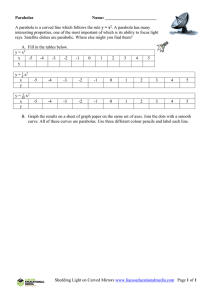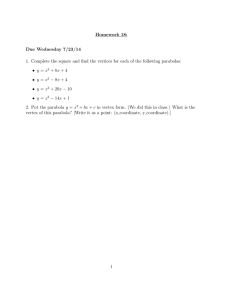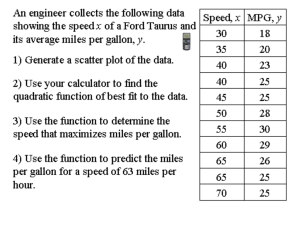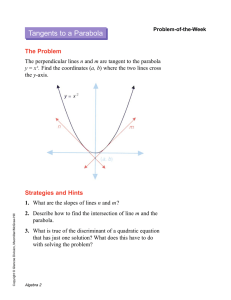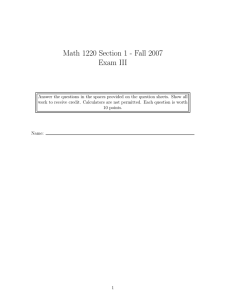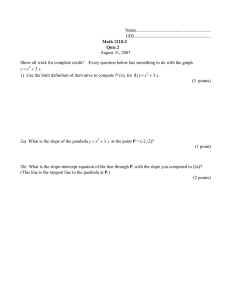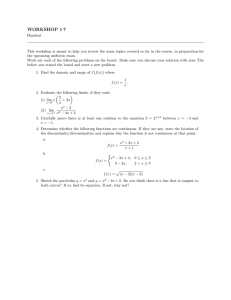THE MOST GENERAL PLANAR TRANSFORMATIONS THAT MAP PARABOLAS INTO PARABOLAS
advertisement
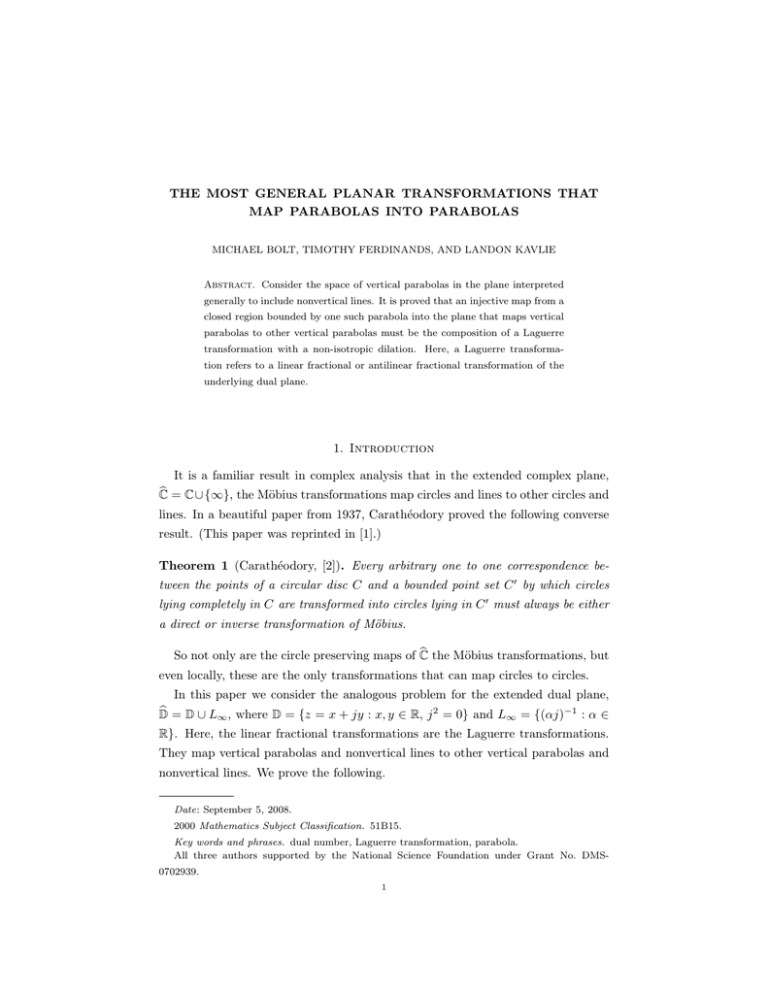
THE MOST GENERAL PLANAR TRANSFORMATIONS THAT
MAP PARABOLAS INTO PARABOLAS
MICHAEL BOLT, TIMOTHY FERDINANDS, AND LANDON KAVLIE
Abstract. Consider the space of vertical parabolas in the plane interpreted
generally to include nonvertical lines. It is proved that an injective map from a
closed region bounded by one such parabola into the plane that maps vertical
parabolas to other vertical parabolas must be the composition of a Laguerre
transformation with a non-isotropic dilation. Here, a Laguerre transformation refers to a linear fractional or antilinear fractional transformation of the
underlying dual plane.
1. Introduction
It is a familiar result in complex analysis that in the extended complex plane,
b
C = C ∪ {∞}, the Möbius transformations map circles and lines to other circles and
lines. In a beautiful paper from 1937, Carathéodory proved the following converse
result. (This paper was reprinted in [1].)
Theorem 1 (Carathéodory, [2]). Every arbitrary one to one correspondence between the points of a circular disc C and a bounded point set C 0 by which circles
lying completely in C are transformed into circles lying in C 0 must always be either
a direct or inverse transformation of Möbius.
b the Möbius transformations, but
So not only are the circle preserving maps of C
even locally, these are the only transformations that can map circles to circles.
In this paper we consider the analogous problem for the extended dual plane,
b
D = D ∪ L∞ , where D = {z = x + jy : x, y ∈ R, j 2 = 0} and L∞ = {(αj)−1 : α ∈
R}. Here, the linear fractional transformations are the Laguerre transformations.
They map vertical parabolas and nonvertical lines to other vertical parabolas and
nonvertical lines. We prove the following.
Date: September 5, 2008.
2000 Mathematics Subject Classification. 51B15.
Key words and phrases. dual number, Laguerre transformation, parabola.
All three authors supported by the National Science Foundation under Grant No. DMS0702939.
1
2
MICHAEL BOLT, TIMOTHY FERDINANDS, AND LANDON KAVLIE
Theorem 2. Every injective map from a closed region bounded by a vertical parabola
or nonvertical line that maps vertical parabolas and nonvertical lines to vertical
parabolas and nonvertical lines is the composition of a non-isotropic dilation dλ :
(x, y) → (λx, λ2 y), 0 6= λ ∈ R, with a direct or indirect Laguerre transformation.
This theorem arose from work that two of the authors did to solve a BeckmanQuarles type theorem for the dual plane. In particular, they proved the following.
Theorem 3 (Ferdinands & Kavlie, [3]). Suppose T is a bijective mapping on the
space of vertical parabolas so that for vertical parabolas A, B,
δ(A, B) = 1 if and only if δ(T (A), T (B)) = 1.
Then T is induced by a Laguerre transformation of the dual plane.
Here, δ is the distance between (intersecting) parabolas and is measured as the
difference in slopes at their point of intersection. An important step in the proof of
this theorem uses a simpler version of Theorem 2 that has a very different proof.
We mention that planar Laguerre geometry often refers to a geometry of oriented
circles where distance is measured as the length of the common tangent. The
connection to dual numbers is made clear in Yaglom [5]. We mention, too, that
the transformations we call Laguerre transformations can also be interpreted as
parabolic Möbius transformations. See, for instance, the recent survey by Kisil [4].
2. Geometry in the extended dual plane
Here we summarize the properties and geometry of the dual numbers. A comprehensive account is given by Yaglom [5].
A dual number z ∈ D is a formal expression z = x + jy where x, y ∈ R and
2
j = 0. These numbers form a commutative algebra over R where addition and
multiplication are done in the obvious way. One identifies dual numbers with points
in the real plane via x + jy ∈ D ↔ (x, y) ∈ R2 , just like in the case of complex
numbers. The coordinates of z = x+jy are the real part and dual part, respectively.
So x = Real (x + jy) and y = Dual (x + jy). Figure 1 illustrates the geometry of
the dual plane. In particular, addition in D is done by adding position vectors.
Multiplication is done by multiplying the real parts and adding the slopes of the
position vectors. Because of this, the modulus and argument of z are usually defined
def
def
by |z| = |x| and arg z = y/x.
The direct and indirect Laguerre transformations are the linear fractional and
antilinear fractional transformations,
µ(z) =
az + b
cz + d
and
µ(z) =
az + b
,
cz + d
TRANSFORMATIONS THAT MAP PARABOLAS INTO PARABOLAS
y
3
y
z3 =z1 *z2
z3 =z1 +z2
z2
m3 =m1 +m2
z1
z1
x
m1
1 x1
z2
m2
x2
x3 =x1 *x2
x
Figure 1. Addition and multiplication of dual numbers
respectively, where a, b, c, d ∈ D and ad − bc = 1. The condition ad − bc = 1 acts as
a normalization and has no affect on the transformation itself. It is just necessary
b to a line or point.
that Real (ad − bc) 6= 0, else µ maps D
The direct Laguerre transformations form a group that is isomorphic to SL2 (D).
Similar to Möbius transformations, they are generated by the following types:
i) [translation] : µ(z) = z + b for b ∈ D
ii) [rotation and isotropic dilation] : µ(z) = az for a ∈ D, Real (a) 6= 0
iii) [inversion] : µ(z) = 1/z.
These transformations preserve angles (measured as differences in slope); the indirect Laguerre transformations reverse angles.
Both the direct and indirect transformations preserve the space of vertical parabolas and nonvertical lines. (By a vertical parabola we mean that the axis of symmetry
is vertical. The vertical parabolas and nonvertical lines can be described collectively
as the graphs y = rx2 + sx + t for r, s, t ∈ R.) This fact can be verified for the
direct transformations by considering the three kinds of motions mentioned above.
It then follows for indirect transformations, too, since obviously the conjugation
z → z = x − jy preserves the space.
b = D ∪ L∞ can be
By using stereographic projection, the extended dual plane D
viewed as an infinite cylinder as shown in Figure 2. (Laguerre transformations that
do not arise as translations or similarities correspond with affine symmetries of the
cylinder.) In this model, the set L∞ = {(αj)−1 : α ∈ R} corresponds with a line
of points at infinity. By using the transformation µ(z) = 1/z one can see that the
parabola y = rx2 + sx + t intersects L∞ at the point −1/(rj), where r, s, t ∈ R. In
particular, nonvertical lines are the parabolas that intersect L∞ at 1/(0j).
4
MICHAEL BOLT, TIMOTHY FERDINANDS, AND LANDON KAVLIE
L¥
y
H0 jL-1
x
Figure 2. Representation of the dual plane on the Blaschke cylinder
3. Proof of Theorem 2
The proof is modeled on Carathéodory’s. We begin with an injective transformation T : D → D0 that maps vertical parabolas and nonvertical lines completely
in D to other vertical parabolas and nonvertical lines in D0 . Here, D and D0 are
b bounded by a single vertical parabola or nonvertical line. By using a
regions in D
preliminary (direct or indirect) Laguerre transformation, we may assume that D is
the closed region bounded above by the parabola y = x2 ; i.e., D = {y ≤ x2 }.
3.1. Preliminary remark. Using the injectivity, it follows that the number of
intersection points of two parabolas contained completely in D is preserved by T .
For instance, if parabolas p0 and p1 intersect exactly once in D, and are therefore
tangent, then the parabolas T (p0 ) and T (p1 ) also intersect exactly once in D0 ,
and are therefore tangent. (If they intersected twice, then one intersection point
is the image of distinct points on p0 and p1 .) Simply put, injectivity means that
intersection points of parabolas cannot be created or destroyed.
3.2. First normalization. By post-composing T with a direct or indirect Laguerre
transformation, we may also assume
i) T (0) = 0
ii) T ((0j)−1 ) = (0j)−1
iii) T : {y = 0} → {y = 0}
iv) T : {y = x2 } → {y = x2 }.
TRANSFORMATIONS THAT MAP PARABOLAS INTO PARABOLAS
5
To see this, suppose that the original transformation is T0 , and T0 (0) = w0 and
def
T0 ((0j)−1 ) = w1 . If µ1 (w) = (w−w0 )/(w−w1 ), then T1 = µ1 ◦T0 satisfies T1 (0) = 0
and T1 ((0j)−1 ) = (0j)−1 . We must determine a further Laguerre transformation
def
µ2 so that T = µ2 ◦ T1 satisfies i), ii), iii), and iv).
Since T1 ((0j)−1 ) = (0j)−1 , it already follows that T1 maps nonvertical lines to
nonvertical lines.
If p0 = {y = 0} and p1 = {y = x2 }, then in fact, T1 maps p0 to a nonvertical
line p00 through the origin and p1 to a parabola p01 tangent to p00 at the origin.
See Figure 3 for the two possible cases. The set of Laguerre transformations that
y
y
p0 '
p1 '
x
p0 '
p1 '
x
Figure 3. Intermediate configurations during normalization;
cases (i) and (ii)
preserve 0 and (0j)−1 have the form µ2 (z) = az or µ2 (z) = az, where a ∈ D and
Real (a) 6= 0.
For case (i), we use a direct transformation µ2 (z) = az where arg(a) is chosen so
that µ2 (p00 ) = {y = 0} and then |a| is chosen so that µ2 (p01 ) = {y = x2 }. For case
(ii), we use an indirect transformation µ2 (z) = az where the initial conjugation
results in a configuration like case (i), then a is chosen as just described. In both
def
cases, T = µ2 ◦ T1 satisfies i), ii), iii), and iv), and we have exhausted our supply
of Laguerre transformations.
3.3. Parallel lines. Recall that the nonvertical lines are exactly those parabolas
that intersect L∞ at the point (0j)−1 . After the first normalization, T preserves
(0j)−1 , so it follows that T maps nonvertical lines to other nonvertical lines. Since
T also preserves 0, it follows that T maps lines through the origin to other lines
through the origin. (We used this fact in the second step of the normalization in
§3.2.) Finally, parallel nonvertical lines intersect exactly once—the intersection occurs at (0j)−1 . Since T preserves this point, and since T preserves the number of
6
MICHAEL BOLT, TIMOTHY FERDINANDS, AND LANDON KAVLIE
intersection points among parabolas (§3.1), it follows that T maps parallel nonvertical lines to other parallel nonvertical lines. As a special case, T preserves {y = 0},
so it also follows that T maps horizontal lines to horizontal lines.
3.4. Inscribed and circumscribed parabolas for a special unbounded polygon. It is a rather curious fact that the parabolas y = x2 and y = x2 − 1/4 arise
as inscribed and circumscribed parabolas for a special unbounded polygon. The
polygon is constructed from the lines tangent to the parabola y = x2 at points
y
6
5
y = x2
4
3
2
1
-2
-1
y = x2 -14
1
2
x
Figure 4. Inscribed and circumscribed parabolas for a special polygon
that have integer valued coordinates. See Figure 4. Clearly, the parabola y = x2
inscribes the polygon. To demonstrate that y = x2 − 1/4 circumscribes the polygon, we show that the points of intersection of consecutive tangent lines to y = x2
lie on its graph. The line tangent at (k, k 2 ) has equation y = 2kx − k 2 . An easy
calculation then shows that the lines tangent at (k, k 2 ) and (k +1, (k +1)2 ) intersect
at (k + 1/2, k 2 + k). Another easy calculation shows this point lies on y = x2 − 1/4.
3.5. Second normalization. By further composing with a non-isotropic dilation
dλ : (x, y) → (λx, λ2 y), we assume T (1, 1) = (1, 1). This is possible for the following
TRANSFORMATIONS THAT MAP PARABOLAS INTO PARABOLAS
7
reason. If after the first normalization the transformation is T0 , then T0 (1, 1) =
def
(ρ, ρ2 ) for 0 6= ρ ∈ R since T0 preserves {y = x2 }. If λ = ρ−1 then T = dλ ◦ T0
preserves (1, 1). Furthermore, dλ preserves 0, (0j)−1 , {y = 0}, and {y = x2 }. So T
continues to satisfy conditions i), ii), iii), and iv) from §3.2.
Given that T maps horizontal lines to horizontal lines (§3.3) and now T (1, 1) =
(1, 1), it follows that T preserves {y = 1}. But T also preserves {y = x2 }, so it
follows that T preserves both intersection points. In particular, T (−1, 1) = (−1, 1).
Following the two normalizations (which identify the Laguerre transformation
and non-isotropic dilation) we mention that the proof of Theorem 2 will be complete once we show that T is the identity transformation. We first prove that T
reproduces the configuration in Figure 4.
To do this, notice that y = x2 and y = x2 − 1/4 are tangent parabolas—they
intersect only at the point −(1j)−1 ∈ L∞ . Since T preserves {y = x2 }, and
since intersection points cannot be created or destroyed (§3.1), it follows that T
transforms the parabola y = x2 − 1/4 to a parabola y = rx2 + sx + t for r, s, t ∈ R
with s2 − 4(r − 1)t = 0. (This is the required condition for a single intersection
with y = x2 .)
Next, T maps tangent parabolas to tangent parabolas (§3.1) and nonvertical line
segments to nonvertical line segments (§3.3). It also preserves {y = x2 } as well as
the points (−1, 1), (0, 0), and (1, 1). It follows that the parabola y = rx2 + sx + t
must contain the points of intersection of consecutive lines tangent to y = x2 at
(xk , x2k ) for a sequence of real numbers . . ., x−2 , x−1 = −1, x0 = 0, x1 = 1, x2 , . . ..
We will verify that together with the required condition for single intersection, this
demands r = 1, s = 0, t = −1/4, and xk = k for k ∈ Z.
Notice that the line tangent to y = x2 at (xk , x2k ) has equation y = 2xk x − x2k .
From this, one can check that the point of intersection of the lines tangent to y = x2
at (xk , x2k ) and (xk+1 , x2k+1 ) is ((xk + xk+1 )/2, xk xk+1 ). Setting k = −1 and k = 0,
this means the parabola y = rx2 +sx+t must contain points (−1/2, 0) and (1/2, 0).
Together with the condition s2 − 4(r − 1)t = 0, this requires r = 1, s = 0, and
t = −1/4. (The other possibility yields the parabola y = 0. This is ruled out by
injectivity.)
At this point it is established that the parabola y = x2 − 1/4 contains the
intersection points ((xk +xk+1 )/2, xk xk+1 ). After some algebra, this can be restated
as 1 = (xk+1 − xk )2 . So the xk are evenly spaced with xk = k for k = −1, 0, 1. By
injectivity, it follows that xk = k for k ∈ Z.
3.6. Preservation of a dense subset of y = x2 . It follows from §3.5 that the
normalized transformation T preserves the points (k, k 2 ) for k = 0, ±1, ±2, ±3, . . ..
8
MICHAEL BOLT, TIMOTHY FERDINANDS, AND LANDON KAVLIE
Here we show as well that T preserves all points on y = x2 whose coordinates are
dyadic rational, i.e., the coordinates have the form k · 2−q for k, q ∈ Z.
To do this, we construct another polygon like the one in §3.4. In particular,
for fixed q ≥ 1, we draw lines tangent to y = x2 at the points (k 2−q , k 2 2−2q ) for
k = 0, ±1, ±2, ±3, . . .. It is a simple matter to check that the points of intersection
of the consecutive tangent lines are ((2k + 1)2−q−1 , k(k + 1)2−2q ), and the parabola
y = x2 − 2−2q−2 contains these intersection points. As in §3.5, T must transform
this configuration to one consisting of the parabola y = x2 , lines tangent to y = x2
at points (xk , x2k ) for a sequence of real numbers . . ., x−2 , x−1 , x0 = 0, x1 , x2 ,
. . ., and a parabola y = rx2 + sx + t that has a single intersection with y = x2 .
The parabola y = rx2 + sx + t must also contain the intersection points of the
consecutive lines tangent to y = x2 at the (xk , x2k ). Since T was normalized so that
T (1, 1) = (1, 1) and T (−1, 1) = (−1, 1), we know that x−2q = −1 and x2q = 1. The
claim will be proved if we show that r = 1, s = 0, t = −2−2q−2 , and xk = k 2−q for
k ∈ Z.
As things are arranged, T (k 2−q , k 2 2−2q ) = (xk , x2k ) for k ∈ Z. Since T maps
horizontal lines to horizontal lines, it follows that x2k = x2−k , and in particular,
x−k = −xk . This means that the target configuration must be symmetric with
respect to the y-axis. Therefore, s = 0. Already, the single intersection of y = x2
with y = rx2 + sx + t requires s2 − 4(r − 1)t = 0, so now r = 1 or t = 0. The case
t = 0 is ruled out else T transforms the parabola y = x2 − 2−2q−2 to a parabola
y = rx2 that intersects y = 0 exactly once (if r 6= 0) or else infinitely many times
(if r = 0).
We conclude that T transforms y = x2 − 2−2q−2 to a parabola y = x2 + t for
some 0 6= t ∈ R. In fact, since T preserves {y = 0}, it must be that t < 0. (This
also uses §3.1.)
As in §3.5, the intersection points of the lines tangent to y = x2 at (xk , x2k )
have the form ((xk + xk+1 )/2, xk xk+1 ) and they lie on y = x2 + t. It follows that
xk xk+1 = (xk + xk+1 )2 /4 + t, or equivalently, t = −(xk+1 − xk )2 /4 for k ∈ Z. In
particular, the xk are evenly spaced. Since x0 = 0 and x2q = 1, it follows that the
distance from xk to xk+1 is 2−q , and therefore, xk = k 2−q for k ≥ 1. (This also
uses injectivity.) The same kind of argument applies for k ≤ −1. Finally, one finds
easily that t = −(xk+1 − xk )2 /4 = −2−2q−2 .
3.7. Preservation of a dense subset of y < x2 . Guided by Carathéodory’s
argument [2, p.576], we now show that T preserves a set of points that is dense
in y < x2 . To do this, we take all lines that are tangent to the parabola y = x2
at points whose coordinates are dyadic rational. By the previous subsection, T
TRANSFORMATIONS THAT MAP PARABOLAS INTO PARABOLAS
9
preserves these points of tangency (§3.6) along with the parabola y = x2 (§3.2), so
it also preserves the lines tangent to y = x2 at these points (§3.1, §3.3). It then
follows that T preserves each point of intersection of these tangent lines. These
intersection points form a dense subset of y < x2 .
The set includes, in particular, the points (−.5, −2), (0, −1), and (+.5, −2).
(They arise as the intersection points of the lines tangent at x = −2, −1, +1, +2.)
Since T preserves these points, and since T maps vertical parabolas and nonvertical
lines to vertical parabolas and nonvertical lines, it follows that T preserves the
unique vertical parabola containing these points. In particular, T preserves the
parabola y = −4x2 − 1.
3.8. Completion of the proof of Theorem 2. We next show that T preserves
each point of the parabola y = x2 .
Consider the alternative. Since T preserves {y = x2 }, the alternative is that there
is a (non-dyadic) real number b and τ ∈
/ {0, 1} so that T (b, b2 ) = (τ b, τ 2 b2 ). By once
more replaying the arguments from §3.5–3.6, it would follow that T (d · b, d2 · b2 ) =
(d · τ b, d2 · τ 2 b2 ) for dyadic rational d. Moreover, T would map the line tangent to
y = x2 at x = d · b to the line tangent to y = x2 at x = d · τ b.
Following the argument of §3.7, this determines how T would act on the set of
points that arise as the intersection points of lines tangent to y = x2 at x = d · b
for d dyadic rational. On this dense set of points, T (x, y) = (τ x, τ 2 y).
Consider now that d is a fixed (but arbitrary) dyadic rational number. The lines
tangent to y = x2 at x = d·b and x = −2d·b intersect at (−d·b/2, −2d2 ·b2 ), and the
lines tangent to y = x2 at x = −d · b and x = 2d · b intersect at (+d · b/2, −2d2 · b2 ).
These points determine the horizontal line y = −2d2 · b2 . As T maps horizontal
lines to horizontal lines (§3.3), and since the intersection points belong to the set
on which T (x, y) = (τ x, τ 2 y), it follows that T would map the horizontal line
y = −2d2 · b2 to the horizontal line y = −2d2 · τ 2 b2 .
Here lies the contradiction. If τ 2 < 1, choose a dyadic d so that (2b2 )−1 < d2 <
(2b2 τ 2 )−1 . Then the parabola y = −4x2 − 1 intersects the line y = −2d2 · b2 twice,
but after the action of T , the parabola y = −4x2 − 1 does not intersect the line
y = −2d2 · τ 2 b2 . This violates §3.1.
Similarly, if τ 2 > 1, choose a dyadic d so that (2b2 τ 2 )−1 < d2 < (2b2 )−1 . Then
the parabola y = −4x2 − 1 does not intersect the line y = −2d2 · b2 , but after the
action of T , the parabola y = −4x2 − 1 intersects the line y = −2d2 · τ 2 b2 . Again
this violates §3.1.
There is the remaining case τ = −1. For this we identify an asymmetric parabola
preserved by T . For instance, the lines tangent to y = x2 at x = 0, 0.5, 2, 2.5, 4
10
MICHAEL BOLT, TIMOTHY FERDINANDS, AND LANDON KAVLIE
determine intersection points (1, 0), (2, 0), and (1.5, 1.25). These points determine
the parabola y = −5x2 + 15x − 10 that is preserved by T . Next, we choose a dyadic
√
d so that |4bd − 5| < 5/ 3. This condition guarantees that the line tangent to
y = x2 at x = d · b does not intersect y = −5x2 + 15x − 10, but the line tangent at
x = −d · b does intersect y = −5x2 + 15x − 10. Under the action of T , the tangent
line at x = d · b would be mapped to the tangent line at x = −d · b, creating an
intersection with y = −5x2 + 15x − 10. Again the contradiction.
We conclude that T preserves each point of y = x2 , and it follows from the
argument in §3.7 that T preserves all points below y = x2 , since each such point
can be expressed as the intersection of lines tangent to y = x2 . That is, T acts
identically on y ≤ x2 , and following the remark in §3.5, this completes the proof of
Theorem 2.
References
[1] David E. Blair. Inversion theory and conformal mapping, volume 9 of Student Mathematical
Library. American Mathematical Society, Providence, RI, 2000.
[2] C. Carathéodory. The most general transformations of plane regions which transform circles
into circles. Bull. Amer. Math. Soc., 43:573–579, 1937.
[3] Timothy Ferdinands and Landon Kavlie. A Beckman-Quarles type theorem for Laguerre transformations in the dual plane. (Preprint).
[4] Vladimir V. Kisil. Starting with the group SL2 (R). Notices Amer. Math. Soc., 54(11):1458–
1465, 2007.
[5] I. M. Yaglom. Complex numbers in geometry. Translated from the Russian by Eric J. F.
Primrose. Academic Press, New York, 1968.
Department of Mathematics and Statistics, 1740 Knollcrest Circle SE, Calvin College, Grand Rapids, Michigan 49546-4403 USA
E-mail address: mbolt@calvin.edu
Department of Mathematics and Statistics, 1740 Knollcrest Circle SE, Calvin College, Grand Rapids, Michigan 49546-4403 USA
E-mail address: tdf3@calvin.edu
Department of Mathematics and Statistics, 1740 Knollcrest Circle SE, Calvin College, Grand Rapids, Michigan 49546-4403 USA
E-mail address: ljk7@calvin.edu
